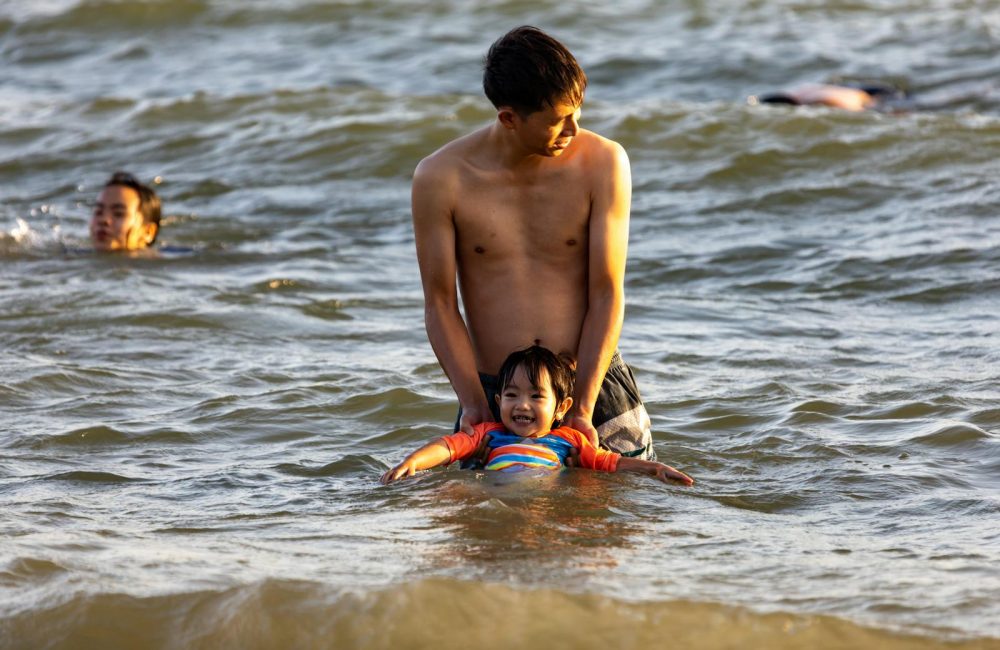Recommended Age to Start Swimming Lessons
Infants and Water Familiarization (0-6 Months)
For newborns and infants under 6 months old, formal swim lessons are generally not recommended. However, water familiarization is a great way to start introducing your baby to the water. During this stage, parents can gently expose their baby to water by holding them securely in shallow water or allowing them to splash in a warm bath. The goal is to make water a positive and fun experience, not to teach formal swimming skills. The American Academy of Pediatrics (AAP) suggests that while it’s okay to expose babies to water at this age, actual swim lessons are not necessary yet. Babies at this stage are not developmentally ready for the structured learning that swim lessons involve.
Practical Tips for Water Familiarization
- Bathtub Play: Use bath time as an opportunity for water play. Let your baby splash around and enjoy the sensation of water on their skin.
- Gentle Showers: Gradually introduce your baby to water by allowing gentle showers over their body, helping them get accustomed to the feeling of water.
- Floating Support: Hold your baby on their back in the water to let them experience buoyancy while feeling secure in your arms.
Baby Swim Classes (6-12 Months)
Between 6 to 12 months, babies can begin to participate in parent-and-baby swim classes. These classes focus on water safety, basic skills, and building comfort in the water. At this stage, babies can learn how to kick, float with support, and get used to water splashing on their face. However, it’s important to manage expectations. At this age, the primary goal is to introduce babies to the water in a safe, fun environment. Babies will not learn how to swim independently at this stage, but they can develop a positive relationship with water, which sets the foundation for future skills.
Examples of Baby Swim Class Activities
- Water Kicking: Encourage your baby to kick their legs while you support their body, fostering coordination and strength.
- Face Dipping: Gently guide your baby to dip their face in the water for a second, helping them build comfort with water contact.
- Floating Support: Use flotation devices to help your baby float while you stay close, ensuring safety and comfort.
When to Start Formal Swim Lessons (1-4 Years)
According to the AAP, the ideal age to start formal swimming lessons is around 1 year old. From ages 1 to 4, children become more coordinated, have better control of their body movements, and are more likely to grasp basic swimming techniques. Starting swim lessons between 1 and 4 years old offers several benefits:
- Water Safety Skills: Early swim lessons can reduce the risk of drowning by teaching critical survival skills like floating, turning to grab the pool’s edge, and safely getting in and out of the water.
- Building Confidence: Children who start swimming at a young age often become more confident and comfortable in the water as they grow older.
- Physical and Cognitive Development: Swimming promotes coordination, balance, and muscle strength. It also supports cognitive development by engaging multiple senses and encouraging problem-solving skills.
Steps for Successful Formal Swim Lessons
- Choose the Right Program: Look for swim programs that focus on safety and have experienced instructors.
- Set Realistic Goals: Understand that mastery takes time. Focus on gradual progress rather than immediate success.
- Regular Practice: Consistent practice helps reinforce skills. Consider scheduling swim sessions a few times a week.
Swim Lessons for Preschoolers (4 Years and Older)
For children 4 years and older, swim lessons should focus more on developing proper swimming techniques, learning strokes, and increasing water safety skills. At this age, children can start learning freestyle, backstroke, and basic swimming techniques that will allow them to swim independently. Children in this age group are more likely to have the attention span and motor skills needed to learn how to swim effectively. Many swimming programs recommend beginning formal stroke instruction around this age.
Techniques for Preschoolers
- Freestyle Basics: Teach your child to coordinate arm and leg movements while maintaining a steady breathing pattern.
- Backstroke Introduction: Introduce the backstroke by practicing floating on the back and gradually adding arm movements.
- Water Safety Drills: Reinforce water safety by practicing safe entry and exit methods and learning to recognize pool boundaries.
Benefits of Starting Swimming Early
Improved Water Safety
Teaching your child how to float, kick, and hold their breath early on can significantly reduce the risk of drowning, which is a leading cause of accidental death in children. Early exposure helps children develop respect for water and understand the importance of safety measures.
Physical Development
Swimming helps develop muscle strength, coordination, and cardiovascular health in young children. It’s an excellent way to keep them active. The resistance of water provides a gentle workout that enhances muscle tone and joint flexibility.
Increased Comfort and Confidence
The earlier a child is introduced to water, the less likely they are to develop a fear of it. Children who start swimming early often become confident swimmers as they grow older. This confidence extends beyond the pool, promoting self-assurance in other areas of life.
Social Interaction
Group swim classes allow babies and toddlers to interact with others, providing early opportunities for socialization. These interactions foster communication skills and teamwork, important social skills that benefit children as they grow.
Potential Risks and Safety Considerations
While early swim lessons have many benefits, it’s important to be mindful of potential risks:
Waterborne Illnesses
Young babies have more sensitive immune systems, making them more vulnerable to waterborne illnesses. Ensure that the pool is clean, well-maintained, and has appropriate chemical levels. Regularly check for signs of illness in your child after swimming.
Preventive Measures
- Check Pool Cleanliness: Inquire about the pool’s maintenance schedule and chemical testing.
- Post-Swim Hygiene: Rinse your child thoroughly after swimming to remove chlorine and other chemicals.
Overconfidence
Parents should be cautious about developing a false sense of security. Even if your child is enrolled in swim lessons, constant supervision is critical. Children can easily tire in the water, and accidents can happen quickly.
Safety Tips
- Stay Within Arm’s Reach: Always be close enough to reach your child quickly in case of an emergency.
- Teach Water Rules: Reinforce the importance of not running near the pool and always waiting for permission before entering the water.
Hypothermia
Babies can get cold quickly in the water, so it’s important to monitor their temperature and use heated pools when possible. Being cold can cause discomfort and increase the risk of illness.
Keeping Warm Tips
- Use Warm Wraps: Wrap your child in a warm towel immediately after swimming.
- Limit Swim Time: Keep swim sessions short to prevent your child from getting too cold.
Swimming Skills Are Not Guaranteed
Early lessons focus primarily on water safety and familiarity. Actual swimming techniques may take years to master. Patience and continued practice are key to progressing from basic skills to proficient swimming.
Tips for Teaching Your Baby How to Swim
Start Slowly
Introduce your baby to water gradually. Begin with short sessions in a shallow pool or bathtub, allowing them to splash and play while feeling safe in your arms.
Make It Fun
Use toys, games, and songs to create a positive and enjoyable experience. Keep sessions short and engaging to hold your baby’s interest and reduce any anxiety they might feel.
Be Patient
Don’t rush the process. Some babies take to water quickly, while others need more time to feel comfortable. Let your baby progress at their own pace and celebrate small milestones.
Focus on Safety
Teach your child basic safety skills, such as floating on their back and holding onto the pool’s edge. Always stay within arm’s reach to provide immediate assistance if needed.
Enroll in Parent-Child Swim Classes
Parent-and-baby swim classes provide a structured environment with professional guidance. They also give you the opportunity to bond with your child while learning important safety tips.
Keep the Water Warm
Use a heated pool or swim during warmer seasons to ensure your baby stays comfortable. Cold water can be a deterrent for young children and may cause them to resist swimming.
Creating a Positive Water Experience
Building a Routine
Establish a swimming routine that your child can look forward to. Consistency helps build familiarity and comfort with water activities.
Encouragement and Praise
Celebrate your child’s achievements, no matter how small. Positive reinforcement boosts confidence and encourages a love for swimming.
Addressing Fear
If your child shows fear or hesitation, address it calmly. Avoid forcing them into the water and instead, offer reassurance and gradual exposure to help ease their fears.
Involving Family
Make swimming a family activity. Involving siblings or other family members can make swimming more enjoyable and less intimidating for your child.
Advanced Swimming Skills for Older Children
As your child grows and becomes more comfortable in the water, they can transition to learning more advanced swimming skills. These skills not only enhance their swimming abilities but also increase their safety in the water.
Learning Different Strokes
Teaching children different swimming strokes, such as breaststroke and butterfly, helps improve their technique and endurance. Each stroke has unique benefits and challenges, keeping swimming engaging and rewarding.
Introducing Diving
For children who are ready, learning how to dive can be an exciting new skill. Start with simple jumps, progressing to diving from the pool’s edge under supervision.
Water Safety Drills
Continuing water safety drills, such as simulating emergency situations where they practice reaching for the pool’s edge or treading water, reinforces safety skills.
Common Mistakes and How to Avoid Them
Rushing Progress
One common mistake is expecting too much too soon. Avoid pushing your child to learn quickly and instead, allow them to develop skills at their own pace.
Neglecting Water Safety
Even if your child is a strong swimmer, never neglect water safety. Constant supervision and adherence to safety rules are crucial to preventing accidents.
Choosing Inappropriate Swim Programs
Not all swim programs are created equal. Research and select programs that prioritize safety and have a solid reputation. Speak to other parents or read reviews to ensure you’re making the best choice for your child.
Ignoring Your Child’s Comfort
If your child expresses discomfort or fear, don’t ignore it. Address their concerns and provide reassurance. Forcing a child can lead to a negative association with swimming.
Conclusion: The Best Age to Start Swimming
The best age to start teaching a baby how to swim depends on your goals. For water familiarization, you can begin as early as 6 months, introducing your baby to the water in a gentle, playful manner. For more structured swim lessons focused on safety and basic skills, 1 year old is an ideal time to begin. As your child grows, they can gradually advance to more formal swimming lessons that focus on technique and independence. Above all, remember that swimming should be a fun and positive experience. Approach the process with patience, prioritize safety, and enjoy the opportunity to create lasting memories with your child in the water.






